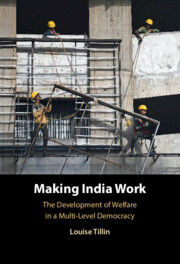Book contents
- Making India Work
- Making India Work
- Copyright page
- Dedication
- Contents
- Illustrations
- Acknowledgments
- Abbreviations
- 1 Introduction
- 2 Origins, Expansion, and Reform
- Part I Building a National Economy: Regulating Internal Competition
- Part II Putting India to Work
- Part III Liberalisation and Welfare in a Multi-level Democracy
- Bibliography
- Index
2 - Origins, Expansion, and Reform
India’s Welfare Regime in Historical Perspective
Published online by Cambridge University Press: 13 February 2025
- Making India Work
- Making India Work
- Copyright page
- Dedication
- Contents
- Illustrations
- Acknowledgments
- Abbreviations
- 1 Introduction
- 2 Origins, Expansion, and Reform
- Part I Building a National Economy: Regulating Internal Competition
- Part II Putting India to Work
- Part III Liberalisation and Welfare in a Multi-level Democracy
- Bibliography
- Index
Summary
This chapter provides an overview of the origins, expansion and reform of India’s welfare regime since the early twentieth century. It outlines the contributions of the book to wider literatures on the histories and politics of social policy in developing countries. The chapter demonstrates interventions in three bodies of literature: firstly, to histories of labour and of the mid twentieth-century democratic and developmental Indian state at the interstices of the colonial and postcolonial eras; secondly, to the literature on the political economy of democracy and development in postcolonial India; thirdly, to the comparative politics literature on welfare regimes beyond Europe and North America. The chapter highlights three factors for their role in shaping the nature of India’s welfare regime over the past century: firstly, the changing shape of India’s model of capitalism; secondly, the gradual deepening of democratic participation; and thirdly, the multi-level territorial articulation of both capitalism and electoral politics.
- Type
- Chapter
- Information
- Making India Work , pp. 20 - 42Publisher: Cambridge University PressPrint publication year: 2025

